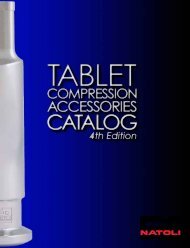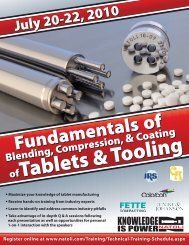The Art of Tablet Compression - Natoli Engineering
The Art of Tablet Compression - Natoli Engineering
The Art of Tablet Compression - Natoli Engineering
Create successful ePaper yourself
Turn your PDF publications into a flip-book with our unique Google optimized e-Paper software.
elieved to be the engineer responsible for designing<br />
the rotary tablet press during his employment with<br />
Parke Davis in the late 1800s. <strong>The</strong> same basic design<br />
– using cams to vertically move the tooling through<br />
the various cycles <strong>of</strong> tablet compression in a turret,<br />
with upper and lower punches and dies – is still used<br />
today. <strong>The</strong> first rotary tablet presses produced 400 to<br />
600 tablets a minute, whereas the modern tablet<br />
presses <strong>of</strong> today can produce more than 100,000<br />
tablets per minute. Innovation is simply matter <strong>of</strong><br />
time.<br />
Q<br />
A<br />
How important is choice <strong>of</strong> excipient in<br />
determining tablet quality?<br />
Choosing the proper excipient is crucial, and plays<br />
a big role in overall tablet quality. Dissolution,<br />
friability and hardness can all be affected. Press speed due<br />
to granulation flow and overall manufacturing efficiency<br />
are also a concern.<br />
Q<br />
A<br />
How does the granulation process contribute to<br />
tablet quality?<br />
Proper granulation is essential for overall tablet<br />
quality. Problems such as sticking, picking, poor<br />
hardness, friability and product flow can result from<br />
improper granulating. As a consequence, excessive fines<br />
can be formed, resulting in tabletting problems such as<br />
tool binding, product scorching or discoloration, and<br />
excessive tool and press wear. This seems to be a<br />
common issue with tablet manufacturers today, as dry<br />
direct compression blends have become the preferred<br />
method. Over-blending a granulation is another<br />
concern that is generally overlooked and can occur in<br />
the tablet press itself. <strong>The</strong> rotary force feeder <strong>of</strong> the<br />
tablet press should always be considered as a mini<br />
blender. <strong>The</strong> feeder paddles aggressively move the<br />
granulation into the die bores, and if the feeders are<br />
overfilled and/or run at too high a speed, the<br />
granulation continues to be blended. This can result in<br />
the over-blending <strong>of</strong> what may have been a good<br />
granulation.<br />
Q<br />
What have been the most significant<br />
advances in tablet compression tooling over<br />
the past decade, and how have these contributed<br />
to tabletting efficiency?<br />
A<br />
In the past decade – other then multi-tip tooling<br />
as mentioned earlier – the most significant<br />
advances have been the Fette Die segments, and the<br />
Courtoy die ring and die shells.<br />
www.iptonline.com<br />
In the past decade, Fette has developed a turret<br />
configuration that eliminates the use <strong>of</strong> traditional dies<br />
and die-locks that hold the dies secure in the die table.<br />
<strong>The</strong> die segments have two major benefits. First, they<br />
increase the number <strong>of</strong> stations in a given diameter <strong>of</strong> a<br />
turret, thereby increasing the number <strong>of</strong> tablets<br />
produced per turret revolution. Second, they<br />
dramatically reduce tablet press set-up time by<br />
eliminating the lengthy and painstaking process <strong>of</strong><br />
setting each die in position. Instead <strong>of</strong> handling,<br />
cleaning and maintaining individual dies, the die<br />
segments require two bolts per segment and are locked<br />
positively in place, while maintaining the proper<br />
alignment <strong>of</strong> the punches into the segment bore.<br />
<strong>The</strong> Courtoy die ring also has advantages over<br />
conventional dies and is more versatile as it allows the<br />
use <strong>of</strong> traditional dies, or alternatively a unique die<br />
configuration called die shells that are held in position<br />
without the use <strong>of</strong> traditional die locks. Unlike the<br />
Fette die segments, the Courtoy system uses a singlepiece<br />
replaceable die ring that substitutes for the<br />
traditional die table <strong>of</strong> a turret. To remove and replace<br />
the die ring, the turret’s upper and lower section<br />
separates allowing unrestricted access to the die ring<br />
for removal and installation. Again, increasing the<br />
number <strong>of</strong> stations in a given diameter <strong>of</strong> a turret<br />
increases the number <strong>of</strong> tablets produced per turret<br />
revolution, while use <strong>of</strong> the die ring instead <strong>of</strong><br />
conventional dies and die locks dramatically reduces<br />
press set-up time.<br />
Q<br />
<strong>Tablet</strong> press tooling comes in a variety <strong>of</strong><br />
sizes and materials. How does this affect the<br />
finished tablet?<br />
A<br />
A variety <strong>of</strong> sizes and configurations are<br />
available, with each configuration having a<br />
unique benefit. <strong>The</strong> most common configurations are<br />
the ‘B’ and ‘D’ types, which are available in the<br />
American and European cam format. <strong>The</strong> ‘B’ type is<br />
smaller in scale than the ‘D’ type and is considered the<br />
most common; it is used by virtually all<br />
pharmaceutical tablet manufacturers. In general, the<br />
different configurations are determined by the<br />
maximum available tonnage, and the output or speed<br />
<strong>of</strong> a tablet press due to fewer tooling stations in a given<br />
turret diameter.<br />
<strong>Tablet</strong> compression tooling is also available in a<br />
variety <strong>of</strong> materials. In order to maintain efficiency,<br />
it is advisable to evaluate several steel types to<br />
determine which material will be best suited for a<br />
17




